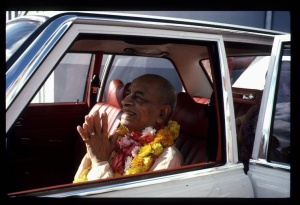CC Adi 7.29-30 (1975)

A.C. Bhaktivedanta Swami Prabhupada
TEXTS 29-30
- māyāvādī, karma-niṣṭha kutārkika-gaṇa
- nindaka, pāsaṇḍī yata paḍuyā adhama
- sei saba mahādakṣa dhāñā palāila
- sei vanyā tā-sabāre chuṅite nārila
SYNONYMS
māyāvādī—the impersonalist philosophers; karma-niṣṭha—the fruitive workers; kutārkika-gaṇa—the false logicians; nindaka—the blasphemers; pāṣaṇḍī—nondevotees; yata—all; paḍuyā—students; adhama—the lowest class; sei saba—all of them; mahā-dakṣa—they are very expert; dhāñā—running; palāila—went away; sei vanyā—that inundation; tā-sabāre—all of them; chuṅite—touching; nārila—could not.
TRANSLATION
The impersonalists, fruitive workers, false logicians, blasphemers, nondevotees and lowest among the student community are very expert in avoiding the Kṛṣṇa consciousness movement, and therefore the inundation of Kṛṣṇa consciousness cannot touch them.
PURPORT
Below is the 1996 edition text, ready to be substituted with the 1975 one using the compile form.
Like Māyāvādī philosophers in the past such as Prakāśānanda Sarasvatī of Benares, modern impersonalists are not interested in Lord Caitanya’s Kṛṣṇa consciousness movement. They do not know the value of this material world; they consider it false and cannot understand how the Kṛṣṇa consciousness movement can utilize it. They are so absorbed in impersonal thought that they take it for granted that all spiritual variety is material. Because they do not know anything beyond their misconception of the brahmajyoti, they cannot understand that Kṛṣṇa, the Supreme Personality of Godhead, is spiritual and therefore beyond the conception of material illusion. Whenever Kṛṣṇa incarnates personally or as a devotee, these Māyāvādī philosophers accept Him as an ordinary human being. This is condemned in the Bhagavad-gītā (BG 9.11):
- avajānanti māṁ mūḍhā mānuṣīṁ tanum āśritam
- paraṁ bhāvam ajānanto mama bhūta-maheśvaram
“Fools deride Me when I descend in the human form. They do not know My transcendental nature as the Supreme Lord of all that be.” There are also other unscrupulous persons who exploit the Lord’s appearance by posing as incarnations to cheat the innocent public. An incarnation of God should pass the tests of the statements of the śāstras and also perform uncommon activities. One should not accept a rascal as an incarnation of God but should test his ability to act as the Supreme Personality of Godhead. For example, Kṛṣṇa taught Arjuna in the Bhagavad-gītā, and Arjuna also accepted Him as the Supreme Personality of Godhead, but for our understanding Arjuna requested the Lord to manifest His universal form, thus testing whether He was actually the Supreme Lord. Similarly, one must test a so-called incarnation of Godhead according to the standard criteria. To avoid being misled by an exhibition of mystic powers, it is best to examine a so-called incarnation of God in the light of the statements of the śāstras. Caitanya Mahāprabhu is described in the śāstras as an incarnation of Kṛṣṇa; therefore if one wants to imitate Lord Caitanya and claim to be an incarnation, he must show evidence from the śāstras about his appearance to substantiate his claim.